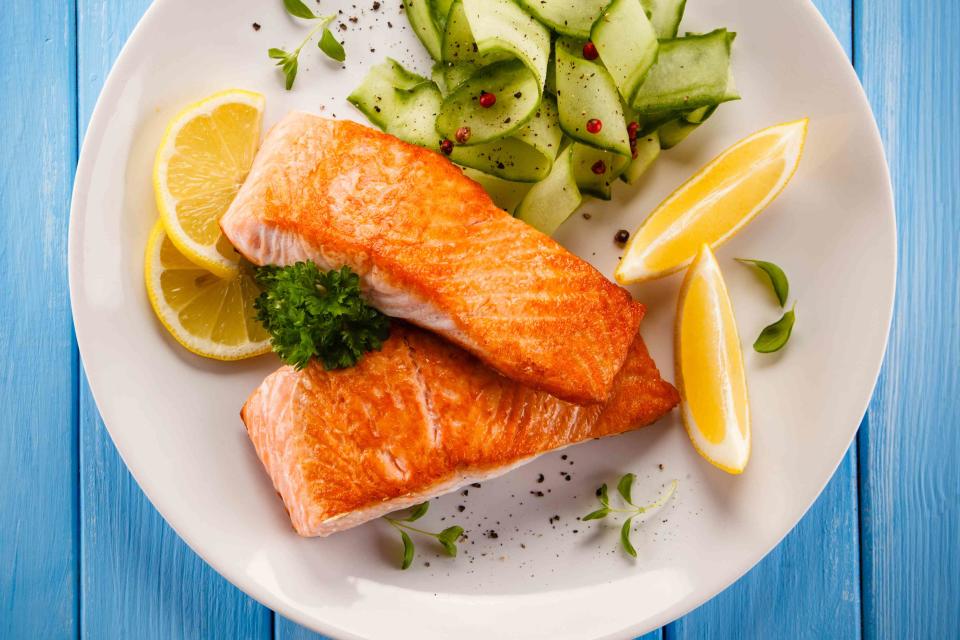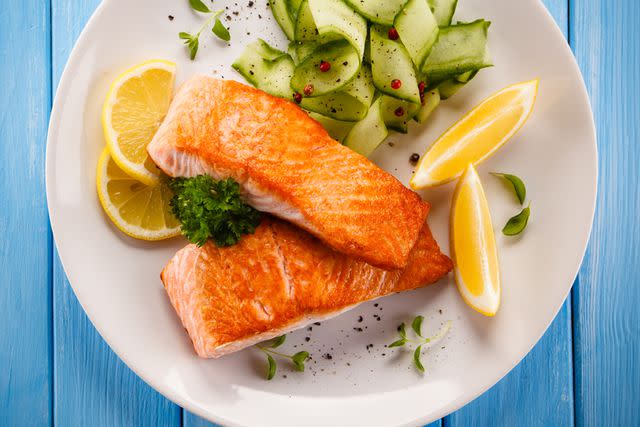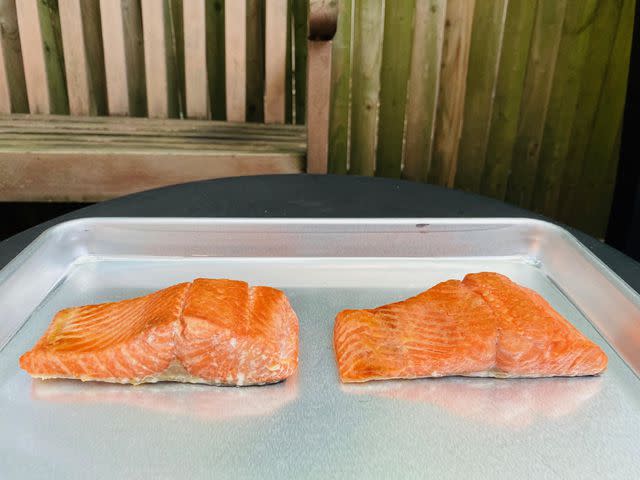How to Avoid the White Stuff When You’re Cooking Salmon
Cooking pros share how to avoid the white stuff that can seep out of cooked salmon, so your fish can look as good as it tastes.

Jacek Chabraszewski/Getty Images
Salmon is healthy, delicious, and simple to prep. But, if you have ever cooked salmon, you probably know what I’m talking about here: that gunky white stuff that seems to leak out of the fish when you cook it. That white stuff is called albumin. It’s tasteless and totally safe to eat, but it is pretty unsightly. I spoke with professional chefs about how to avoid it, and tested their techniques for myself. Spoiler alert: they work! Both methods reduced the appearance of albumin on salmon. Here’s how you can avoid the white stuff on salmon when you’re cooking the hearty fish at home.

Jacek Chabraszewski/Getty Images
What Is Albumin?
But first, what exactly is this stuff? “Albumin is a protein found in animal products and even some plants,” says Shawn Matijevich, Lead Chef of Online Culinary Arts & Food Operations at the Institute of Culinary Education. If you think the albumin in salmon resembles cooked egg whites, well, there’s a reason for that! Albumin proteins are also found in egg whites. “Albumin is flavorless and harmless,” says Matijevich.
How to Reduce Albumin
Though albumin may be harmless, it's not necessarily something we want to look at while eating. Aesthetics matter too! Here are two techniques to reduce the amount of albumin that salmon releases while cooking.
Related: How to Buy the Best Fish at the Grocery Store, According to Fishmongers
Technique #1: Salt the Fish First
Chef Amara Enciso is the chef and owner of Brava Food in Juneau, Alaska. Enciso specializes in preparing wild Alaska seafood, chiefly salmon, and swears by this method for reducing the albumin released in the fish. “Sprinkle a light amount of kosher salt on both sides of salmon filets. Let it sit for 15 minutes. Then, rinse off the salt, dry the filets, re-season them, and cook them by searing them on the stove-top and finishing them in the oven.”
Could it be that easy? I tested out Enciso’s method at home to see if it worked. I bought two 4-ounce pieces of Alaska sockeye salmon, and laid them side-by-side on a plate. I salted one generously with kosher salt, and let them both sit at room temperature for 15 minutes. I gently rinsed the salted piece, and dried it with a paper towel. I rubbed both filets with olive oil, and seasoned them both lightly with kosher salt. (I knew it wouldn’t be too salty, since I had rinsed off the first sprinkle of salt.) Then, I seared the salmon flesh-side down over medium-high heat in a nonstick pan for about 3-4 minutes, until the filets were nicely browned on top. I transferred the filets, skin side down, to a foil-lined baking sheet and baked them at 425 degrees until they were cooked to my liking, about medium.

Jenna Helwig
When I examined the fish, the difference between the two filets was clear. The one that had been salted released significantly less albumin.
Even though Enciso prefers the searing-roasting combo for cooking salmon, I wanted to see what would happen if I tried the salting routine on two pieces of basic baked salmon. I followed the same salting, resting, rinsing, and drying method on one filet. But then, instead of searing the fish first, I just put the filets in a 350-degree oven and cooked them for about 13 minutes. While the fish that had been pre-salted released some albumin, it was noticeably less than the fish that hadn’t been pre-salted. Victory!
The reason this technique—basically dry-brining—works is because salting the fish reduces albumin through a biological process called facilitated diffusion, Matijevich explains. “The salt content on the surface and the salt content of the cells in the salmon are different, and it causes an exchange of fluid through the cell membranes of the salmon. This draws out the albumin from the outer layer of the flesh, and it gets rinsed off before you cook.”
Related: 13 Healthy Fish and Shrimp Recipes for Any Night of the Week
Technique #2: Low and Slow
Another way to avoid visible albumin on salmon is to cook it gently in the oven. In a recipe in his forthcoming cookbook, Seafood Simple, acclaimed chef Eric Ripert explains, “Cooking salmon slowly at a low temperature doesn’t cause it to release albumin, so it remains inside the flesh, making the fish tender and giving it an even consistency when cooked.”
There are plenty of ways to dress up salmon when you’re cooking it this way. Ripert’s recipe includes topping it with an herb and lemon-infused olive oil before cooking. But the basic method is even simpler. Place the fish–either individual filets or a 1 to 2-pound piece—in a baking dish. Cover it liberally with olive oil, and season it with salt. Bake at 275 or 300 degrees until cooked to your liking. Ripert’s recipe calls for a two-pound piece of salmon to cook at 275 for 15 to 18 minutes (although knowing my tastes, I'd probably cook it a little longer).
While I did test this method out (and it worked!), honestly I didn't need to. This is how I cook salmon most frequently. It's easy, hands-off and, yup, keeps the salmon a pretty pink without a lot of white stuff on it. And that makes sense, says Matijevich. “Cooking salmon gently helps keep it from overcooking, and overcooked salmon releases more albumin."
How to Remove Albumin After Cooking
Maybe you’ve pre-salted the fish, but you still let it cook too long, and it’s an albumin party on the surface. Or, perhaps you were in a hurry and didn’t have time to let the salmon hang out in the oven. Whatever the reason, you’ve got albumin on your filets! Here’s how to handle it.
Related: The 15 Best Side Dishes for Salmon
While you could take a damp paper towel to gently brush off the white stuff from the fish, Matijevich has a better idea—one that will actually add flavor and moisture to the salmon. “Just brush off the albumin with a pastry brush that is loaded with some melted butter or olive oil.” Simple!
Now that you know how to reduce the amount of albumin that’s released when you’re cooking salmon (or how to fix it if it does occur), it's time to get cooking! Try one of our favorite salmon recipes, and enjoy!
For more Real Simple news, make sure to sign up for our newsletter!
Read the original article on Real Simple.


